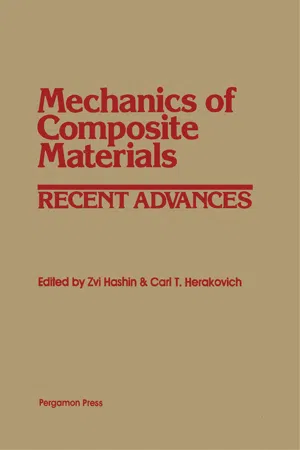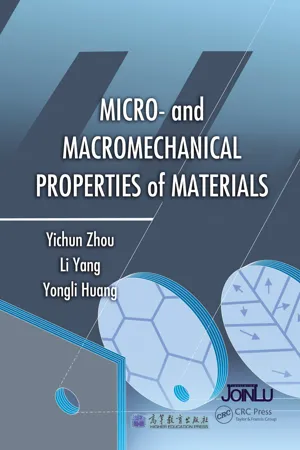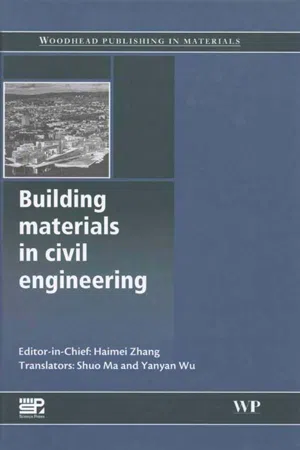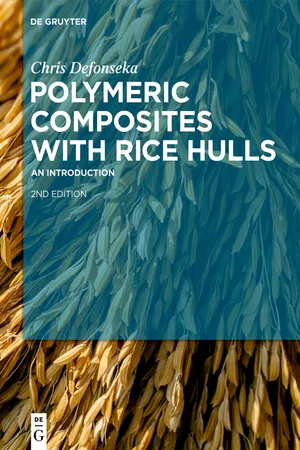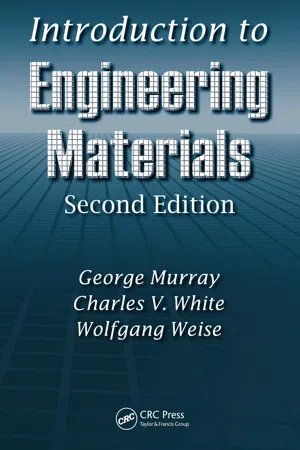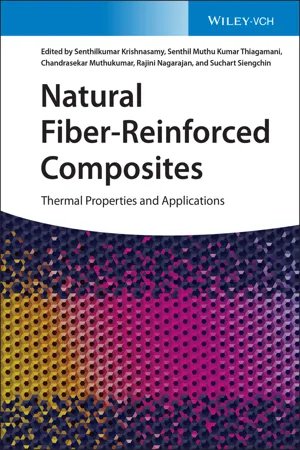Technology & Engineering
Properties of Composite Materials
Composite materials are engineered materials made from two or more constituent materials with significantly different physical or chemical properties. These materials are designed to exhibit unique properties that are not present in any single constituent material alone. The properties of composite materials can be tailored to meet specific performance requirements, making them widely used in various industries such as aerospace, automotive, and construction.
Written by Perlego with AI-assistance
Related key terms
1 of 5
10 Key excerpts on "Properties of Composite Materials"
- eBook - ePub
- Ever J. Barbero(Author)
- 2017(Publication Date)
- CRC Press(Publisher)
Chapter 2Materials
Composite materials are formed by the combination of two or more materials to achieve properties (physical, chemical, etc.) that are superior to those of its constituents. The main components of composite materials, or composites, are fibers and matrix. The fibers provide most of the stiffness and strength. The matrix binds the fibers together thus providing load transfer between fibers and between the composite and the external loads and supports. Also, it protects the fibers from environmental attack. Other substances are used to improve specific properties. For example, fillers are used to reduce the cost and improve processability and dimensional stability [50 ].The design of a structural component using composites involves simultaneous material and structural design. Unlike conventional materials (e.g., steel), the properties of the composite material can be designed simultaneously with the structural aspects. Composite properties (e.g., stiffness, thermal expansion, etc.) can be varied continuously over a broad range of values, under the control of the designer. The objective of this chapter is to describe the constituents used in the fabrication of the composite material. The capabilities and limitations of various processing techniques used to fabricate the material and the parts are presented in Chapter 3 .A brief review of the most common types of materials used in the fabrication of composites is presented in this chapter, with emphasis on properties, advantages, disadvantages, and cost. No attempt is made to explain how fibers and polymers are produced; excellent material science books and handbooks cover that subject [51 –53 ]. Comprehensive lists of material suppliers can be found in specialized publications [54 ,55 ], trade associations [56 ,57 ], or the World Wide Web. Another important aspect of design and fabrication is to have standard test methods to verify the material properties used in design [58 - eBook - PDF
Mechanics of Composite Materials
Recent Advances
- Zvi Hashin, Carl T. Herakovich, Zvi Hashin, Carl T. Herakovich(Authors)
- 2013(Publication Date)
- Pergamon(Publisher)
MECHANICAL Properties of Composite Materials* R. M. Christensen Chemistry and Materials Science Department Lawrence Livermore National Laboratory, Livermore, CA ABSTRACT An assessment is given of the means of predicting the mechanical Properties of Composite Materials in terms of the microstructure properties. Fiber reinforced composites are considered as well as other types of heteroge-neous combinations of materials. Various geometric models of microstructure characteristics are discussed. Primary emphasis is given to elasticity results, although some viscoelasticity and plasticity formulations are considered. KEYWORDS Composites; fiber reinforced; particulate; mechanics; elasticity. INTRODUCTION Composite materials are continuously displacing the traditional materials of engineering design and construc-tion. Composite materials often show considerable advantages of stiffness and strength over homogeneous material formulations. The advantage is particularly evident when these properties are considered on a per unit weight basis. In addition, composite materials have emerged as being energy efficient when considered on a total life cycle basis. With these driving forces, composite materials technology has grown at a rapid rate. The present work is concerned with an assessment of the means of predicting the mechanical properties of compos-ite materials. Such information is of use and importance in the design process. The term composite materials is used here in the rather broad sense of meaning heterogeneous combinations of materials. We do not seek the most general models of behavior, rather we give emphasis to those means which have a strong basis in the mechanics of continuum behavior. For example, it is possible to devise mathematical models which mimic the behavior of actual two phases systems which undergo phase inversion as the relative volume fractions of the two phases are varied. Such models typically contain empirical parameters to be adjusted to data. - eBook - PDF
- Mikell P. Groover(Author)
- 2012(Publication Date)
- Wiley(Publisher)
What is a composite material? 2.41. Identify some of the characteristic Properties of Composite Materials. 2.42. What does the term anisotropic mean? 2.43. Name the three basic categories of composite materials. 2.44. What are the common forms of the reinforcing phase in composite materials? 2.45. What is a cermet? 2.46. Cemented carbides are what class of composites? 2.47. What are some of the weaknesses of ceramics that might be corrected in fiber-reinforced ceramic- matrix composites? 2.48. What is the most common fiber material in fiber- reinforced plastics? 2.49. Identify some of the important properties of fiber- reinforced plastic composite materials. 2.50. Name some of the important applications of FRPs. 48 Chapter 2/Engineering Materials 3 PROPERTIES OF ENGINEERING MATERIALS Chapter Contents 3.1 Stress–Strain Relationships 3.1.1 Tensile Properties 3.1.2 Compression Properties 3.1.3 Bending and Testing of Brittle Materials 3.1.4 Shear Properties 3.2 Hardness 3.2.1 Hardness Tests 3.2.2 Hardness of Various Materials 3.3 Effect of Temperature on Mechanical Properties 3.4 Fluid Properties 3.5 Viscoelastic Behavior of Polymers 3.6 Volumetric and Melting Properties 3.6.1 Density and Thermal Expansion 3.6.2 Melting Characteristics 3.7 Thermal Properties 3.7.1 Specific Heat and Thermal Conductivity 3.7.2 Thermal Properties in Manufacturing The properties of a given engineering material determine its response to the various forms of energy that are used in manufacturing processes. If the material responds well to the forces, temperatures, and other physical parameters generated in a particular process, the result is a successful operation that produces a high-quality part or product. Material properties can be divided into two categories: mechanical and physical. The mechanical properties of a material determine its behavior when subjected to mechani- cal stresses. These properties include stiffness, ductility, hardness, and various measures of strength. - Hota V.S. GangaRao, Narendra Taly, P. V. Vijay(Authors)
- 2006(Publication Date)
- CRC Press(Publisher)
19 2 Properties of Constituent Materials: Concrete, Steel, Polymers, and Fibers 2.1 INTRODUCTION Development of composite materials represents a milestone in the history of our civilization. Along with conventional building materials such as steel, concrete, alu-minum, and wood, composite materials offer an excellent alternative for a multitude of uses. Use of composite materials was pioneered by the aerospace industry beginning in the 1940s, primarily because of the material’s high-performance and lightweight qualities. Today their potential is being harnessed for many uses. Advanced composite materials — so called because of their many desirable properties, such as high-performance, high strength-to-weight and high stiffness-to-weight ratios, high energy absorption, and outstanding corrosion and fatigue damage resistance — are now increasingly used for civil engineering infrastructure such as buildings and bridges. Composite materials are manufactured from two or more distinctly dissimilar materials — physically or chemically — that are suitably arranged to create a new material whose characteristics are completely different from those of its constituents. Basically, composites consist of two main elements: the structural constituent, which functions as the load carrying element, and the body constituent called matrix , which encloses the composite. The structural constituent can be in the form of fibers, particles, laminae (or layers), flakes, and fillers. The matrix performs important dual functions: It acts as a binder to hold the fibrous phase in place (i.e., holds the fibers in a structural unit) protecting fibers from environmental attack, and under an applied load, it deforms and distributes the load to the high modulus fibers. Composites discussed in this book are those fabricated from fibers such as glass, carbon, aramid, and boron.- Yichun Zhou, Li Yang, Yongli Huang(Authors)
- 2013(Publication Date)
- CRC Press(Publisher)
14 Mechanical Properties of Composite MaterialsWhy is a racing bike much lighter than an ordinary bike, yet more durable? Why has the loading capability of a modern flight been increasing while the weight of the aircraft has been reduced? This is because more composite materials have been used in a racing bike, or in a modern airplane, instead of steel and other metallic materials. The reason that composite materials have high performance—materials such as glass fiber-reinforced plastic (GRP) and carbon fiber-reinforced plastic composites-is due to their structural complexity.In recent years, there have been increasing demands in the development of advanced materials. Composite materials have been one of the key players due to their combination of two different material components, each with its own advantages. In fact, many natural materials, including biological materials, are composite materials that make our lives easier and more colorful. So far, composite materials have been widely used in the fields of aerospace, energy, transportation, and architecture, as well as in industrial machinery, the biomedical industry, and in sport. We could even say that when we entered into the twenty-first century, mankind also entered the era of composite materials. With the development and application of composite materials, the field of composite materials mechanics was created, and has been extensively developed [1 ,2 ].In this chapter, the definition, characteristics, and development of composite materials will be introduced. Then we will focus on their mechanical properties, including elasticity, strength, and the fracture properties of two typical composite materials: fiber-reinforced composite materials and particle-enhanced composite materials. Finally, new trends in the development of composite materials will be discussed.- eBook - ePub
- Haimei Zhang(Author)
- 2011(Publication Date)
- Woodhead Publishing(Publisher)
2The Basic Properties of Building Materials
This chapter discusses the components, the structures of materials and the influence of their compositions on the properties; it emphasizes on the physical properties and the mechanical properties of materials; and also it introduces the decorativeness and the durability of materials.In the civil engineering, building materials plays different roles, so they should possess corresponding properties. For example, structural materials should have good mechanical characteristics; waterproof materials should be impermeable and water-resistant; wall materials should be heat-insulating and sound-absorbing. In addition, building materials should be durable because they often affected by various external factors, such as wind, rain, sun and frost.The basic properties of building materials include physical property, mechanical property, durability and decorativeness. The commonness of the properties is discussed in this chapter and their specialties will be discussed in relevant chapters.2.1 Compositions and Structures of Materials and the Influence of Their Constructions on the Properties
2.1.1 The Compositions of Materials
The compositions of materials include chemical compositions and mineral compositions which are the key factors for the properties of materials.1 Chemical Composition
The chemical composition refers to the chemical constituents. Various chemical compositions result in different properties. For example, with the increase of carbon content, the strength, hardness and toughness of carbon steel will change; carbon steel is easy to rust, so stainless steel comes into being by adding chromium, nickel and other chemical components into steel.2 Mineral Composition
Many inorganic non-metallic materials consist of a variety of mineral compositions. Minerals are monomers and compounds with a certain chemical components and structures. The mineral compositions are the key factors for the properties of some building materials (such as natural stone, inorganic gel and other materials). Cement reveals different characteristics because of different clinkers. For example, in Portland cement clinkers, the condensation hardening is fast and the strength is high when the content of tricalcium silicate—the clinker mineral—is high. - eBook - ePub
Polymeric Composites with Rice Hulls
An Introduction
- Chris Defonseka(Author)
- 2019(Publication Date)
- De Gruyter(Publisher)
Fibrous glass-reinforced thermoplastics and HIPS in sheet form can be cold-formed similar to that seen for metal sheet stamping. These products will have long reinforcements and special additives to improve the strength:mass ratio. During the forming process, a sheet is pre-heated to ≈198.8 °C and then formed on normal standard steel stamping presses. It is possible to produce parts with complex designs and varying wall thicknesses with this method. Production rates will be dependent upon the equipment used but, in general, on average outputs ≈200 per h can be achieved. Common products made this way are: motor covers, housings, appliance bodies, seat backs, outdoor furniture, automotive interior trims and many others.3.3 General properties of composites
The designer of composite products must have a good knowledge of the properties and behavioural patterns of the individual constituent materials to be used to achieve the maximum desired properties of the final composite. In the context of polymeric composites, a sound understanding of polymer properties will help greatly. Hence, one may make use of the many information sheets on the properties and specifications of polymers available. In this section, only the relevant properties of polymeric composites that are important for the practical end applications of these composites are discussed:- – Density
- – Compressive strength
- – Impact strength
- – Permeability and sorption
- – Weathering
- – Warping
- – Water absorption
- – Friction and wear
- – Fatigue
- – Aesthetic properties
3.3.1 Density
Density is the mass (weight) per unit volume of a material or product. It is commonly expressed as g/cm3 in the metric system but the appropriate SI-derived unit of density is kg/m3 - eBook - PDF
- George Murray, Charles V. White, Wolfgang Weise(Authors)
- 2007(Publication Date)
- CRC Press(Publisher)
• The high-tech systems of the aerospace, electronics, nuclear, medical, and some chemical industries: These designs frequently require new or recently developed materials, many of which are engineered. The aerospace industry leads the way in development of new materials, and some eventually filter down to the more established technologies. A good example of the latter are the boron and silicon carbide fibers and their composites that were first used in the space shuttle, other aircraft, and missiles that are now being widely used to manufacture sports equipment: skis, golf clubs, tennis rackets, fishing poles, boats, and the like. In the materials selection process for either of these categories, assuming that we are considering materials that are available or can be made available on reasonably short notice, it helps to know in what ballpark the materials of interest for a particular application might be found. For example, if the materials are 490 Introduction to Engineering Materials, Second Edition going to experience temperatures in excess of 500°C , should we waste our time and effort considering polymers and polymer matrix composites? Let us narrow our field of consideration as quickly as possible. After all, we have many thou-sands of materials from which to choose. Our fist objective is to reduce this number to a few hundred. This is analogous to the block diagram approach used for detecting failures in electronic equipment. We must first isolate the block of interest. It is the intent of this chapter to establish some general categories that should assist us in narrowing the field of possible materials for any given appli-cation. In this chapter the cost of the materials is not included. These figures fre-quently change and for many of the newer materials are often unknown. 17.2 COMPARATIVE MECHANICAL PROPERTIES The mechanical properties of paramount interest in most designs are those of strength, hardness, ductility, fatigue, and fracture toughness. - eBook - ePub
Natural Fiber-Reinforced Composites
Thermal Properties and Applications
- Senthilkumar Krishnasamy, Senthil Muthu Kumar Thiagamani, Chandrasekar Muthukumar, Rajini Nagarajan, Suchart Siengchin, R. Nagarajan(Authors)
- 2021(Publication Date)
- Wiley-VCH(Publisher)
18 Physical, Mechanical, and Thermal Properties of Fiber-Reinforced Hybrid Polymer Composites Subramanian Ravichandran1 , Suresh Sagadevan2 , and Md Enamul Hoque3 1 Sathyabama Institute of Science and Technology, Department of Physics, Chennai, 600119, India 2 University of Malaya, Nanotechnology& Catalysis Research Centre, Kuala Lumpur, 50603, Malaysia 3 Military Institute of Science and Technology (MIST), Department of Biomedical Engineering, Mirpur Cantonment, Dhaka, 1216, Bangladesh18.1 Introduction
The recent increase in the usage of composite technology in the materials science and engineering sector is due to the possibility of creating novel architectures with hybrid properties compared with that of the single components. For the successful use of this technology principles, the role and selection of reinforcing phase are critical as it provides the strength and stiffness to the composite, and so the reinforcement material forms help to generate stronger, harder, and stiffer composites. The commonly used reinforcing materials are applied in the form of fibers/particles and are generally originated from polymers, glass, plastic, carbon, ceramics, Kevlar, and natural plant-based ones like kenaf, jute, silk, cotton, etc. [1 –7 ]. For example, the fiber-reinforced polymer (FRP ) composites are the structures that can be applied as the major load-bearing substituents and also face many challenges to explore toward its applications in many different sectors [1] . Similarly, the glass-reinforced polymer s (GRP s) are the strongest and the most resistive ones to the deforming forces, and the extent of its restiveness is decided by the orientation of the fibers. When the force is exerted parallel to the orientation of the fiber, the composites serve as the strongest while the weakest in the case of the force applied perpendicular to the fiber [8] . Taking into consideration the fiber orientation-based resistive properties offered by the GRP-mediated nanocomposites, they are used mostly for the manufacturing of artificial human parts, prosthesis, and dental implants [9] . Similarly, the GRP-based nanocomposites when used in the manufacturing of machine parts for the automobile and other engineering sectors, although their mechanical properties are indicated to be resistant against fractures, often involve in wear and tear and are due to the failures of generating the homogeneous phase composites [10] - Frank R. Jones(Author)
- 2022(Publication Date)
- Cambridge University Press(Publisher)
5 Mechanical Properties of Composite Materials This chapter describes the mechanical performance of a fibre composite. A number of variables that control deformation and fracture are discussed: continuous or discon- tinuous fibres; fibre angle; fibre length; the transfer of stress between matrix and fibre at a short fibre and/or a fibre-break; and the role of the matrix. Individual components can fracture independently and control the micromechanics; the redistribution of stress after these events is discussed. 5.1 Continuous Fibre Reinforcement Figure 5.1 shows a unidirectional continuous fibre composite with parallel continuous fibres illustrating that the elastic modulus (or Young’s modulus) differs with the direction of the applied stress. Therefore, four principle moduli are defined: E 1 ðor E ι Þ, E 2 ðor E t Þ, E 3 ð¼ E ι Þ; E θ , where E is the elastic modulus under tension and G is shear modulus. σ, ε, τ, and γ are the stress, strain, shear stress, and shear strain, respectively. The subscripts 1 (l), 2 (t), and 3 (t) represent the loading direction with respect to the fibres (Figure 5.1). Within this chapter, f, m, and c refer to the properties of the fibre, matrix (resin or other continuous phase), or composite. u refers to the ultimate property, so that strength is defined as σ cu and failure strain as ε cu . 5.1.1 Longitudinal Modulus With a tensile load parallel to the fibres and assuming a perfect interfacial bond, the strain in the composite (ε c ) equals the strain in the matrix (ε m ) which equals the strain in the fibres (ε f ). Therefore: ε c ¼ ε m ¼ ε f : (5.1) Since σ f ¼ E f ε 1 and σ m ¼ E m ε 1 and E f > E m , (5.2) then σ f > σ m : (5.3) Consider a load, P c , across the cross-sectional area (CSA), A c , of the composite: P c ¼ σ 1 A c , P c ¼ P f þ P m , P f ¼ σ f A f , P m ¼ σ m A m , P c ¼ σ f A f þ σ m A m , σ 1 ¼ E 1 ε 1 : Therefore, eq.
Index pages curate the most relevant extracts from our library of academic textbooks. They’ve been created using an in-house natural language model (NLM), each adding context and meaning to key research topics.

